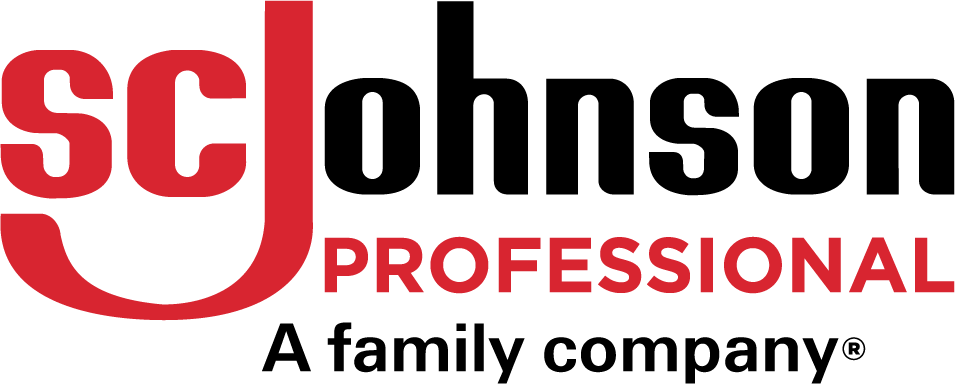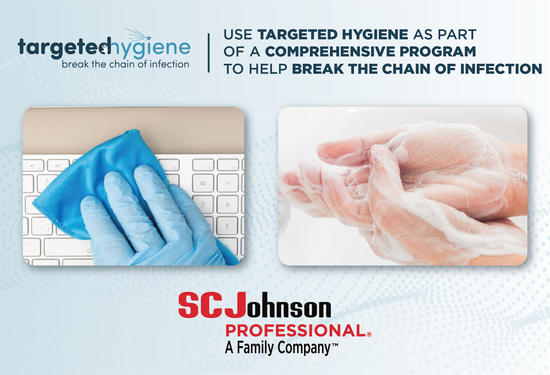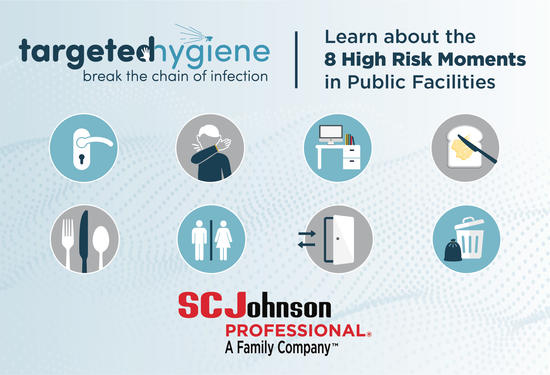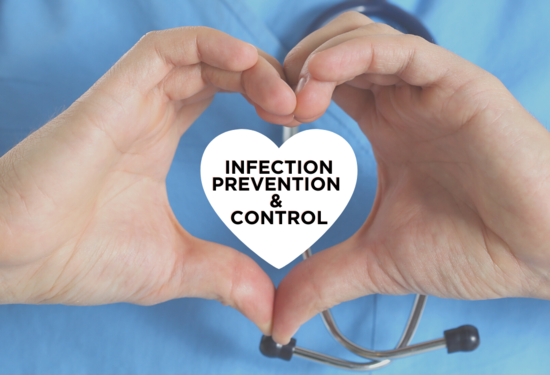How the New (Cleaning) Norm Will Affect Opening Strategies for Businesses
By Dr. Elizabeth A. Scott, PhD. IFH Scientific Advisory Board Member
Dr. Elizabeth Scott, PhD.

Dr. Elizabeth (Liz) Scott Professor and Consultant. Expertise in home and community hygiene and infection control. Research and communication in applied microbiology, infection control and hygiene practices in home and everyday life settings.
SC Johnson Professional has partnered with Dr. Scott to produce a series of articles and educational resources in response to the COVID-19 pandemic.
Infectious disease experts around the world always knew there was the potential for a new pandemic. With the arrival of COVID-19, the cleaning industry and the way the world views cleaning and personal hygiene may be forever changed. A new standard of cleanliness has emerged, and businesses will need to shift their focus from “cleaning for appearance” to “cleaning for health,” which means more infection prevention protocols will be included in cleaning programs to help avoid the spread of pathogens.
As businesses continue to reopen, it’s critical to develop a comprehensive cleaning program throughout facilities to meet higher expectations around cleaning that starts with identifying the moments of high-risk infection transmission. Customers and employees will want assurance that they’re walking into locations with disinfected surfaces and options for hand hygiene. However, in order to move forward, it’s important to also understand one of the most important questions: How did we get here?
The Age of Sanitary Reform
In the mid-19th century, the Sanitary Reform Movement was founded in Europe and the United States in response to increasing industrialization and urbanization that resulted in massive overcrowding and outbreaks of infectious disease leading to high levels of morbidity and mortality. Removing filth and providing sanitation and clean water became a focus for improving living conditions and preventing infectious disease.
At about this time, the Sanitary Reformers also started to offer advice to householders on cleaning and personal hygiene practices. This carried into the 20th century and became one of the drivers of the cleaning and household products industry and was even incorporated into Home Economics classes. However, at some point around the middle of the 20th century, when antibiotics and vaccines became freely available, some in the medical community thought that infectious diseases would be a thing of the past. It was implied that the general public no longer needed to take measures to protect themselves against infections in their home and everyday lives at work, at school and in sports facilities, etc.
From the early 2000s there was a movement to encourage less hygiene in the belief that being “too clean” could be detrimental to our health. At the same time, we have seen the constant emergence of new pathogens. Pathogens, which are disease-causing organisms like bacteria and viruses, include respiratory infections produced by strains of coronavirus and influenza virus that prompt concerns about a possible global pandemic.
The onset of the COVID-19 pandemic showed just how unprepared we really were and how we urgently need to restore the public’s understanding of hygiene, specifically targeted hygiene, as a tool for helping to break the chain of infection and reduce transmission of infectious diseases.
How COVID-19 Changed the Cleaning Industry
The World Health Organization (WHO) officially declared COVID-19 a global pandemic on March 11, 2020 and with it came demands for a new standard of cleanliness and disinfection. Understanding and following the sciences of cleaning and disinfection provides the public with assurance when frequenting and using facilities. To continue to provide these assurances cleaning strategies need to be continually evaluated to meet the standards that are informed by science and health agencies, while also conveying the role that public can take to improve individual hygiene behaviors when using public spaces.
The expectation of having a targeted cleaning strategy with improved cleaning protocols will continue to rise, and facility managers must have the proper tools to pinpoint the moments of high-risk infection transmission.
Develop a Plan
To rebuild customer and employee confidence, facility managers must consider prioritizing cleanliness by developing a comprehensive strategy that includes appropriately cleaning and disinfecting. Employees and customers have gained a heightened awareness around cleanliness. They will rely on facility managers to implement a robust cleaning plan that follows guidelines set by experts such as the Center for Disease Control and Prevention (CDC) and WHO.
Facility managers should start by evaluating the workplace and identifying areas that need to be cleaned and disinfected. Available cleaning tools, personal protective equipment (PPE) and the types of surfaces to be cleaned should all be taken into consideration when developing a comprehensive cleaning and disinfection program.
Additionally, facility occupants will need to improve facility hygiene behavior at the moments of high-risk infection transmission. In fact, there are eight moments where driving behavioral change should be focused as outlined in SC Johnson Professional’s Targeted Hygiene Program. Inspired by the CDC’s hand hygiene guidelines and the risk management approach for hygiene – known as ‘Targeted Hygiene’ which was developed by the International Scientific Forum on Home Hygiene (IFH), the 8 moments include:
- Touching common surfaces
- After coughing, sneezing, blowing your nose
- Returning to and leaving your workspace
- Getting food prepared
- Eating food
- Touchpoints in a restroom
- Entering and exiting the building
- Disposing of waste
Improved Cleaning Protocols
To maintain and improve cleaning protocols, it’s important to implement tactics such as:
- Identifying High-Risk Environmental Surfaces: Consider the types of surfaces that are more likely to become contaminated during daily activities. Surfaces such as doorknobs, toilet flush handles, faucet handles, furniture and light switches represent especially high-risk transmission areas. There are four points to be considered in developing targeted surface decontamination practices including: 1) the probability of the considered targeted high-risk (common-touch) surface becoming contaminated with pathogens; (2) the types of pathogens that are most likely to survive on these surfaces and also remain viable in sufficient numbers for long enough to create a potential for the risk of transmission; (3) the likelihood of pathogen transfer from the contaminated surface to human hands and to other surfaces and hosts; and (4) the susceptibility of the new human hosts to acquiring infection.[1]
After identifying high-risk surfaces, businesses should practice routine and targeted cleaning in order reduce the number of germs on surfaces and disinfect surfaces to kill any remaining germs.[2] Utilize disinfectants that are included on the United States Environmental Protection Agency list as approved for use against SARS-CoV-2, the virus that causes COVID-19.
- Following label instructions and contact times: Product labels include safety and application instructions, which are important to follow when disinfecting surfaces. Labels specify contact times needed for proper disinfection. For example, if a product has a stated contact time of two minutes, that means that the surface should remain wet with the disinfectant for at least two minutes. If the disinfectant should dry up or be wiped away before two-minutes have passed, the effectiveness of the product will decrease. Additionally, label instructions will list precautions such as wearing PPE or double-checking proper ventilation, so it doesn’t cause harm to users.
- Prioritizing hand hygiene: To help reduce the spread of germs, the CDC recommends washing hands for at least 20 seconds with soap and warm water followed by thorough drying or by practicing proper hand sanitization.[3] An important way to prioritize handwashing is by ensuring soaps and sanitizers with documented efficacy are always readily available. Prioritizing hand hygiene can help mitigate the chain of transmission for germs transferring from workers’ hands to other surfaces or to other people. Frequent and thorough hand hygiene is essential for helping to reduce the spread of germs throughout facilities.
- Keeping supplies stocked: Although COVID-19 made it more difficult for some businesses to secure cleaning essentials, you should make certain to keep supply cabinets stocked with sufficient supplies to maintain a high level of personal and building hygiene.
Continuous Protection and Prevention
Developing a targeted cleaning and disinfecting routine is essential to reducing the risk of exposure to SARS-CoV-2 through contact with high-risk surfaces. Frequency should be determined by the number of high-risk surfaces, facility size and number of building visitors. At the minimum, public facilities should be cleaned and disinfected daily ensuring special attention is placed on those targeted, high-risk surfaces.
In addition to facility managers implementing proper cleaning and disinfecting protocols, it is important for building occupants to continue practicing safe behaviors around the 8 moments of high-risk infection transmission in order to help mitigate the spread of infection. Employees and customers should also continue to socially distance, wash hands frequently, wear appropriate face coverings, cover coughs and sneezes, avoid touching their face and disinfect high-touch surfaces to help ensure a safe reopening.
[1] A 21st century view of infection control in everyday settings: Moving from the Germ Theory of Disease to the Microbial Theory of Health:Elizabeth A. Scott PhD a, *, Elizabeth Bruning BSc (Honors), LLB b , Raymond W. Nims PhD c , Joseph R. Rubino BA, MA b , Mohammad Khalid Ijaz DVM, MSc (Honors), PhD, FRSPH b,d



